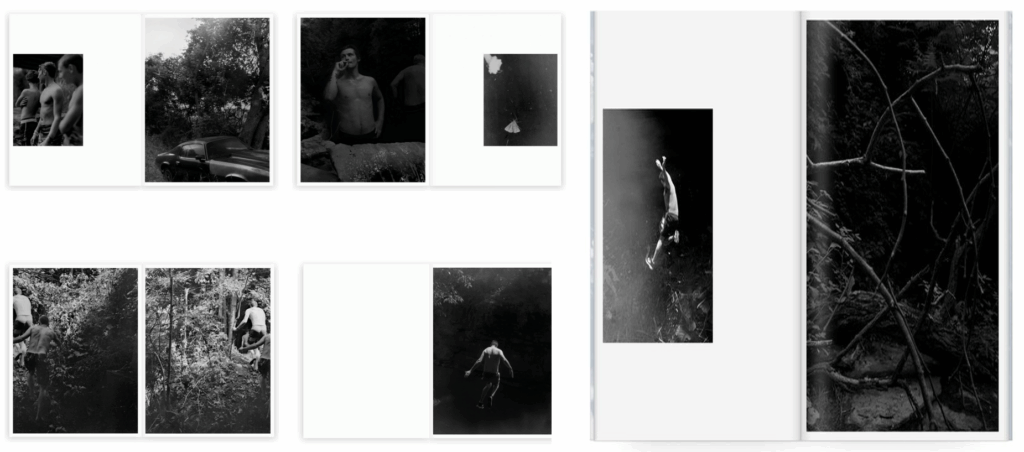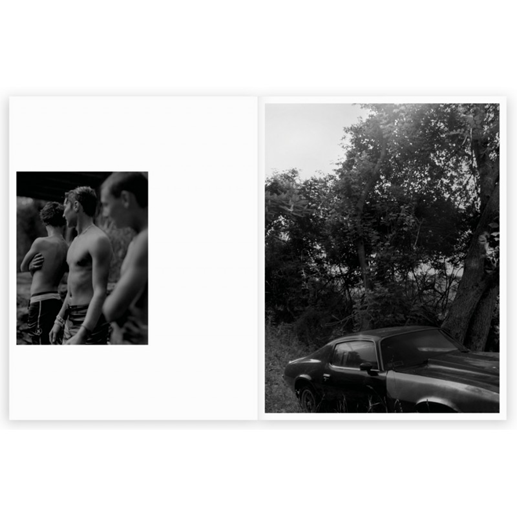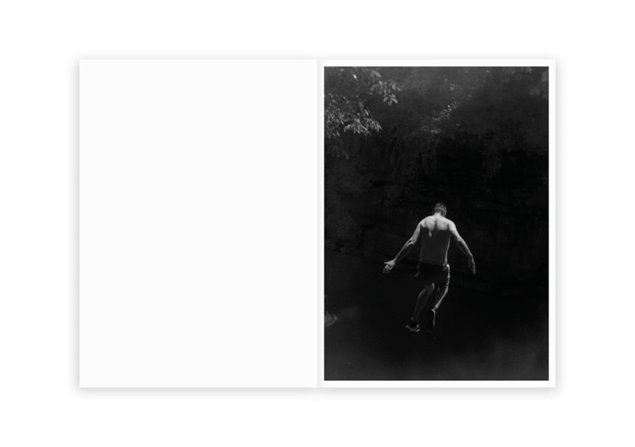A photobook is a personalised book that features a collection of photographs arranged in a cohesive and creative layout. Most of them have an overall theme or follows a specific storyline. Photobooks provide photographers with a convenient and cheap way of showing their work to a large audience. Most photobooks tend to not have text and if there is, its very minimal. This means that the photographs tend to explain the story they’re trying to convey rather than relying on text.
Deconstructing a photobook
Halfstory Halflife – Raymond Meeks

What the book is about:
Raymond Meeks’ photobook called ‘Halfstory Halflife’ is a book about teenagers growing up in a small town in New York. Over three years Meeks documented a group of teenagers who gathered each summer at a secluded spot called Furlong. Here, they would leap from a 60 foot bridge into the water below. This was a tradition for the teenagers in the area and symbolised their transition from adolescence to adulthood. He spent a few years taking black and white photographs of the moments before they jumped, while they were in the air and as they hit the water. By looking at the images, you can see and feel a variety of different emotions like: excitement, fear and freedom, all of which comes alongside growing up. However, the book wasn’t just meant to be about capturing teenagers jumping off a bridge, it’s supposed to be about that specific time in life when you’re typically trying to figure out who you are. To me, the title suggests how these moments he captured are just one tiny part of a bigger story for each individual in the book and how being a teenager is like living in between two stages of life as you’re not a child anymore but also do not have all the responsibility and stress of an adult, making it difficult for you to find your place in society. This invites those who look at the book to reflect on their own experiences of transition and self discovery. The title ‘Halfstory Halflife’ is drawn from a poem by Dean Young and reflects the project’s exploration of incomplete narratives and the transition between childhood and adulthood.
Why there are images of cars throughout:

The car images seen throughout the book helps to tell the story of teenage freedom and the spaces they inhabit. For example, cars are often seen as a symbol of independence as by having a car, it allows the teenagers seen in the photobook to get to these hidden places in the woods that are away from adults, school and routine. This is important to them as these places and things often have authority over them, meaning they must listen and do whatever is asked of them. But, by having a car, this means they can get away from these places and go wherever they want without being told what to do. However, Meeks could have also added these images of cars parked in natural settings to show the contrast between human made and natural spaces and how these teens temporarily claim a spot in nature. Additionally, the still images of cars juxtapose the action shots of the teenagers jumping into the water and creates a break in the book, giving a feeling of waiting, resting or being in between moments. This matches the book’s tone of exploring transition and reflection. I also think the images of the cars are a way of showing that a person and story has occurred in these places, even if the people are gone, the objects remain and act as a reminder of its past.
Why he photographs the back of people rather than the front:

Whilst looking through the book, I also noticed that the majority of the images Raymond Meeks took is of people from behind. I think this creates a sense of distance and mystery to the book as we can’t actually see who these people are and so can’t build any sort of relationship with them. I think he did this to allow for the people viewing his book to reflect on their own memories of being a teenager as they aren’t distracted by the people photographed in the book’s facial expression. Additionally, by him photographing the people from behind, it makes them seem more vulnerable and exposed as they aren’t acting for the camera. This links to the theme of the book being about growing up and feeling unsure during this journey. Meeks intention with this idea of not photographing people face on was to make the people in the images act as a stand ins for the viewer. This is important as it means we aren’t focussing on who they are but what they’re feeling.
Structure of the book/ how it looks:
In the photobook, Meeks only includes images that are black and white and ensures that there’s only one image on each side of a page. I think he did this to encourage reflection in the people viewing his work as they aren’t distracted by any flashy colours or overstimulated by too many images being on one page. The cover of the book is a wraparound cover and is soft. The cover includes an image of someone walking through a wooded area with their back to the camera. Additionally, the image has a blue-grey tint over it and the opacity is quite low. I think he chose this for multiple reasons. Firstly, the faded blue colour creates a feeling of nostalgia, quietness and melancholy. This matches the reflective and emotional vibe of the photobook and so I think the cover is purposefully created like that to set the tone for the book. To add onto that, the fact that the image is quite faded makes the book feel more old and like a possession you would stumble upon years later in your house, causing a rush of memories to come flooding back to you. He could’ve also decided on the blue colour as it represent the photographs inside which involve jumping into water and capturing the natural landscapes. Therefore, the blue colour echoes the skies, rivers and lakes seen throughout the photobook. I think he chose this simple cover design as it creates a sense of mystery and intrigue in the viewer as you can’t really understand what the book is about just from looking at the front cover, therefore encouraging the viewer to actually open up the book and discover more.
What inspired him to make the book:
Raymond Meeks was inspired to create Halfstory Halflife by his discovery of a hidden spot near his home in the Catskill Mountains known locally as Furlong. Over many summers he observed teenagers gathering there to leap from a 60 foot waterfall into the water below. He was initially drawn in by the dramatic look and contrast between the teenager’s bodies flying mid air and the natural landscape. However, as he observed more, he soon began to see these carefree, fun acts as a ritualistic transition from adolescence to adulthood. He compared the area to an altar, with the teenagers’ jumps representing an offering or sacrament. This perspective was influenced by his Catholic upbringing. Additionally, the title ‘Halfstory Halflife’ was inspired by a poem by Dean Young. His project focuses on masculinity, vulnerability and the profound moments that define the journey from youth to maturity.
“If you could just say I feel lost here and I am going home. For where on Earth would you buy that ticket. Who would meet you when you go there. By what sign would they know you”.
